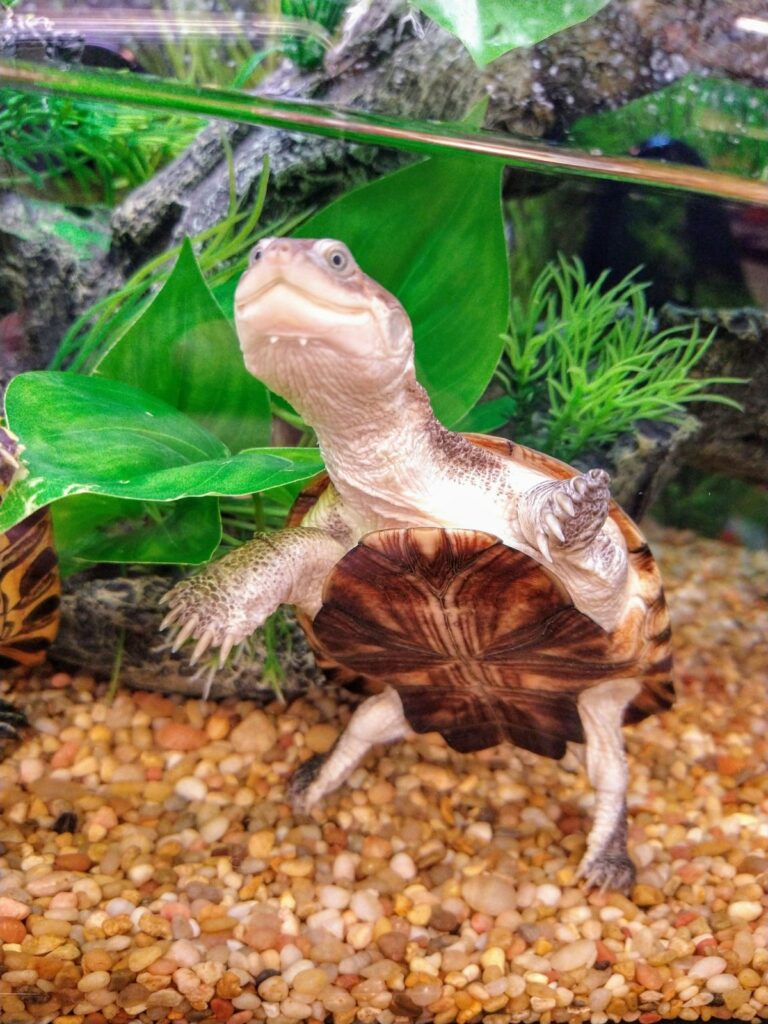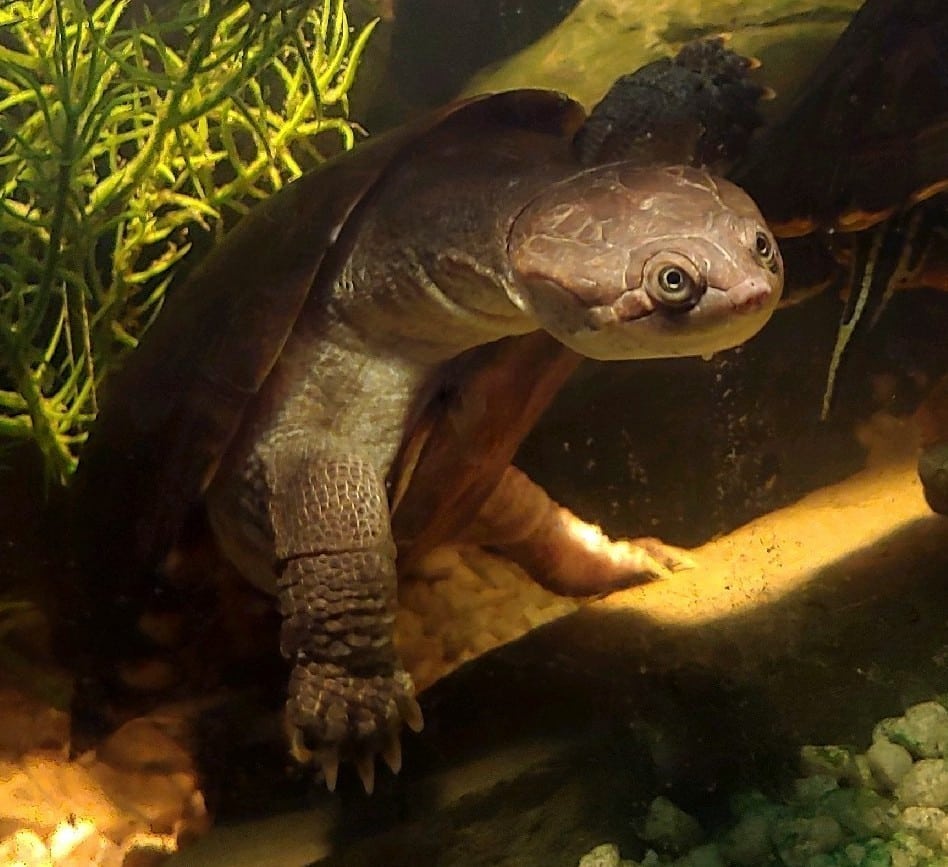African Sideneck Turtles are one of the few species not native to the Americas that are often seen in local pet stores. Unlike Map Turtles or Red Eared Sliders, African Sideneck Turtles are not very colorful. But as prehistoric-looking and easy to care for as they are, this species is a good choice for beginners looking for something different.

What is the African Sideneck Turtle?
African Sideneck Turtles have a couple of interesting tricks. Their long neck can’t be retracted into the shell, as other turtles do when threatened. At first, this might seem somewhat dangerous.
Instead, the turtle folds their neck sideways to fit the head into the shell. The head gets tucked alongside one of their shoulders. Their long necks also enable these turtles to right themselves if flipped onto their backs. Most turtles are somewhat helpless if flipped over onto their backs.
African Sideneck Turtles are also capable of moving far from water if seasonal sources dry up. They will travel overland, seeking new places to live. And if they don’t find water they will bury into the mud and enter a state of hibernation.
There, they sleep until the rain returns, which might take months, or even years. Spells of extreme cold or heat may also trigger African turtle species to enter hibernation until normal temperatures return.
African Sideneck Turtle Lifespan
African Sideneck Turtles are one of the longer lived aquatic turtle pet species. 30 to 50 years is average for a well cared for specimen. And a few will live to be even older.
- Common Names: African Sideneck Turtle, African Helmeted Turtle, Marsh Terrapin, Crocodile Turtle
- Scientific Name: Pelomedusa subrufa
- Origin: SubSaharan Africa + Yemen
- Length: 8 to 12 inches
- Aquarium Size: 75 gallons
- Lifespan: 30 to 50+ years
- Ease of Care: Easy
African Sideneck Turtle Care: Tank Setup
I cover all of the specifics on African Sideneck Turtle care in this comprehensive guide. But if you’re looking for additional info, I have plenty of extra tips here for setting up a turtle tank.

How Big Do African Sideneck Turtles Get?
African Sideneck Turtle size depends a lot on the sex of the animal you end up with. Aquatic turtles show extreme sexual dimorphism: meaning the male and females are easy to tell apart by looking at them. 8 to 12 inches is typical for adult females, with males being 3 to 4 inches shorter.
Female aquatic turtles are much bigger than males. A male Side Neck turtle will also have longer claws on his forelimbs that he uses to grasp a female during mating.
Lighting for African Helmeted Turtle
Choosing the right lighting for an African Sideneck Turtle habitat is key to succeeding long-term with one. A visible light bulb is not enough – you also need to provide both infrared (heat) and ultraviolet (UBv) radiation.
As ectothermic animals an African Slider turtle has a metabolism regulated by the environment. The hotter the ambient temperature the faster it will move, the better it will digest its food, and so on. Likewise, cold temperatures slow growth and will even depress the immune system of your Long Neck Turtle pet.
A basking bulb should cover the land area of an African Sideneck Turtle tank setup. The ambient air temperature needs to remain around 80-90°F.
Be sure to check the surface temperature of the basking zone as well so that it grows non hotter than 96°F. Otherwise the surface might burn the belly of your pet turtle.
UVb radiation is essential for Vitamin D3 synthesis. Some commercial turtle pellets and powder supplements are enriched with Vitamin D3. But it’s not known for sure if turtles can get the vitamin from food like humans can.
It’s better to provide the right lighting for an African Sideneck Turtle. And that means running UVb alongside heat and visible light.
Water Conditions for African Crocodile Turtles
The water temperature for African Sideneck Turtle tank setups should remain around 80°F. These animals need to have plenty of heat, so a submersible turtle tank heater is essential.
Any heater you choose also needs a plastic heater guard to protect it. Diving turtles may crack or shatter the glass elements, exposing the interior to water. Which may result in the turtle being electrocuted.
A submersible or hang on the back turtle tank filter is also important. Like all aquatic turtles, African Side Neck Turtles will eat and poop in the swimming area. In just a few days, ammonia and bacteria will start to build up in an unfiltered tank. Not to mention it will smell terrible in the room your turtle tank is in.
Even with a powerful turtle tank filter you should perform regular water changes to keep the system fresh. Water changes and filtration ensures the turtle tank water remains free of pathogenic bacteria and ammonia.

What Do African Sideneck Turtles Eat?
Aquatic African turtles are omnivorous and eat both plant and animal material. Crayfish, fish, insects, worms, and amphibians they catch are the core of their diet. With frequent helpings of soft aquatic plants.
One reason they are called Crocodile Turtles is due to their ambush hunting strategy. By working in groups African Sideneck Turtles will catch and drown doves and other birds that come to drink.
A proper African Sideneck Turtle diet should include as much variety as possible. Local pet stores carry mealworms, hissing roaches, and other bugs. Nightcrawler earthworms, and chunks of seafood like fresh fish are also a favorite treat of theirs.
Mix their protein with vegetables like romaine lettuce, chard, squash, pumpkin, and grated carrots. You could even offer soft fruit that’s been skinned, like pieces of apple, melon, strawberries, and grapes.
A vitamin powder supplement rich in calcium should also be dusted on meals every so often. Calcium ensures the shell of your African Sideneck Turtle remains strong and durable. Vitamin A deficiencies are also common in this species, manifesting as swollen, pus-filled eyes. So make sure your powder supplement contains this essential nutrient.
A baby African Sideneck Turtle should be fed every day as much as it will eat in 5 minutes. Once they become a full size African Sideneck Turtle and growth slows down, you will switch to feeding 2 to 3 times per week.
Conclusion
African Sideneck Turtle care is not too difficult as long as you buy the right lights and water filtration. They aren’t pets that enjoy being handled but they are active swimmers and very engaging to watch.
Just remember that they are prone to certain vitamin deficiencies. So include not just a varied diet but also supplemental powders to ensure your turtle lives for decades to come.
More Frequently Asked Questions About African Sideneck Turtles
African Aquatic Sideneck Turtles are one of the easier species to care for. But like all aquatic turtles they do have their quirks. So here are a few frequently asked questions I get about this species.
Like most aquatic turtle species the African pet turtle is not good for hobbyists that want an animal they can handle. Turtles will become stressed if held often. And they may respond with bites or scratches when they’ve had enough.
While African turtles are not poisonous they will transmit dangerous bacteria from their skin, in their mouths, and from the water. A bite wound might become infected to the point of needing a hospital visit.
You should only handle African Side Neck Turtles as needed when doing aquarium maintenance, however. If the shell of your turtle becomes overgrown with algae, or you need to investigate an injury, you might need to handle it. Otherwise, stick to watching your turtle from the other side of the aquarium glass, hands-free.
It is never a good idea to mix different pet turtle species together. There are too many variables and you won’t know if there is a problem until it’s too late. Some turtles are peaceful towards different species. But others may become aggressive and territorial. A disease that’s harmless to one turtle may be fatal to an African Sideneck Turtle. It’s best to only keep turtles of the same type in an aquarium.
African sideneck Turtles will try to eat fish that live in their aquarium. You may have some luck with very small fish and a full grown African Sideneck Turtle, however. As long as your turtle is well fed it may decide tiny fish are too much work to hunt down. These can include Zebra Danios, Guppies, and other small, fast moving species. Any larger fish will be too tempting to ignore. Sooner or later the turtle will corner and eat their tank mates.

